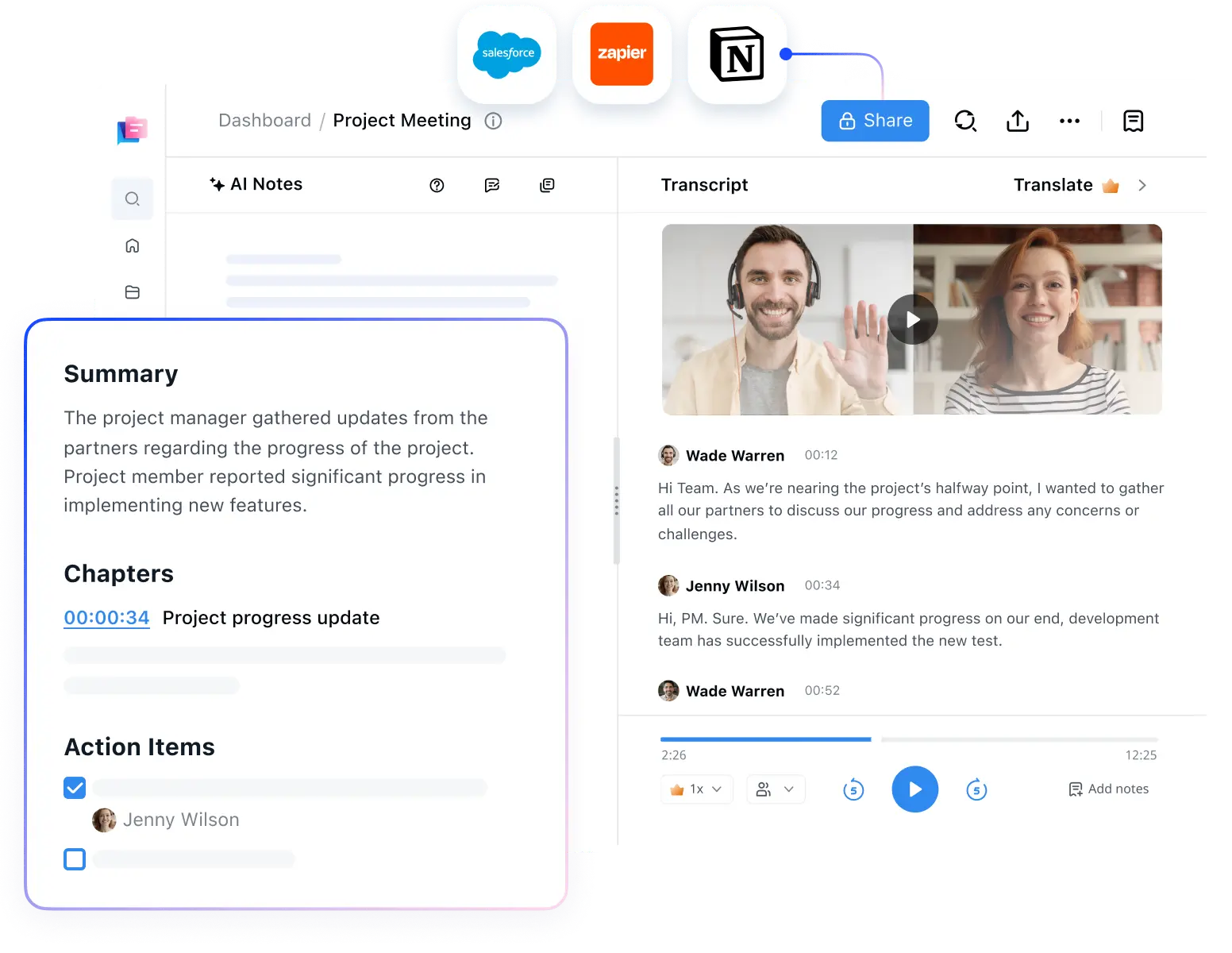
No-Meeting Days: What They Are & How to Set Them
Unlock the power of AI — Notta's meeting assistant records, transcribes and summarizes meeting minutes with one click.
Sometimes, the smallest change can make a big difference in how fast the work is completed. For me, it's keeping some days completely clear of meetings. Instead of attending those obligatory Monday morning meetings or those daily status update sessions, the idea of a no-meeting day is to eliminate all meetings and focus on what matters most: work! And I'm not alone. In fact, many employees feel the same way.
It's pretty easy for scheduled meetings to multiply and take up too much of the workweek, and at the very point, all the important tasks can fall through the cracks. There are many solutions for this, but many companies are implementing no-meeting days to help employees be fully free of meetings and work on priority tasks. Here, I'll reveal what a no-meeting day is and how you can implement one.
What is a no-meeting day?
A no-meeting day is a specific day of the week or month that's free of unnecessary (or necessary!) meetings. It's a meeting-free day where everyone can block out their calendar, focus on the important tasks, and get work done.
In fact, MIT Sloan Management Review surveyed around 76 companies with 1000+ employees that implemented some sort of no-meeting days per week. Those who opted for one no-meeting day in a week saw a 35% rise in overall productivity, which increased to 71% for those who opted for two weeks.
Benefits of no-meeting days
No-meeting days mean the whole company cancels weekly team check-ins, project kickoffs, status updates, 1:1s, and any other meeting that might be scheduled. If you're still unsure if meeting-free days can be beneficial for you (and your team), here are some of the benefits that might convince you:
Improved mental health: It's no wonder that meetings can be stressful and exhausting. Keeping one day a week completely free of meetings can make a big difference in your mental health. When you get everything done on time, there's no to-do list in your head — which is a big part of mental health benefits.
Reduce stress: Meetings involve preparation, attendance, and post-meeting tasks that need to be completed. Anyone can feel overwhelmed by a constant barrage of meetings on their calendar. A no-meeting day can reduce stress levels and allow the team to focus on their individual work.
Less context switching: Context switching is a major problem that can take you off task, and nobody can complete the work when they're uninterrupted every 30 minutes. No-meeting days mean the entire team can work without distraction for an entire day.
Reduce meeting fatigue: People who often attend back-to-back meetings understand meeting fatigue. No-meeting days will make sure you don't feel overwhelmed or tired all the time. One meeting-free day in a week will definitely leave you more refreshed and focused.
Disadvantages of no-meeting days
There are lots of meetings that are productive and even necessary. For example, if there's an urgent task that needs to be discussed face-to-face rather than over messaging apps or email, you might find no-meeting days less useful. Here, I'll outline some downsides of no-meeting days:
Missed opportunities: Sometimes, no-meeting days can lead to missed important opportunities or information that can only be shared in meetings. For example, there might be an instance when the client would want to discuss something urgent with you and your team on a no-meeting day. For this reason, it's important to understand what meetings can be skipped or rescheduled on a no-meeting day.
Potential disconnection: If you work in a remote team, you probably understand meetings are the only way to help people from different locations come together and discuss ideas. In such scenarios, no-meeting days might prove impractical and lead to potential disconnection between team members.
Miscommunication: Cutting scheduled meetings to zero might lead to communication challenges. It's because limiting the number of meetings also limits the opportunities to collaborate with others. It could also be a reason that can make team morale suffer.
How to implement a no-meeting day
My work often tends to build up throughout the week. That's because when I'm planning to work on something, then another task comes up. That's why no-meeting days or meeting-free days are so great. They give me a chance to catch up on everything that needs to be completed.
I've been trying this for a while, and I'm much more productive on no-meeting days. If you're looking to try something similar, don't overthink it. It's a small thing, but the benefits of meeting-free days are huge. Here's how to implement a no-meeting day so everyone can avoid meetings and calls:
Inform everyone
If you're planning to schedule a no-meeting day for everyone, you'll need to inform everyone on the team so nobody schedules meetings on that day. For example, if all the team members agree, you can opt for no-meeting Fridays. This will help everyone catch up on what was pending and be more productive. This, in turn, will make their weekends better and relaxing.
Be flexible
Not all companies work in a similar way, and the choice of no-meeting day will depend on your needs. You can pick a day each week when employees aren't expected to attend internal or external meetings. If you still somehow get an extra important meeting that cannot be rescheduled or skipped, you may consider scheduling it at the beginning or end of the day.
Prefer other messaging apps
One important thing you'll need to keep in mind is that no-meeting days don't mean no communication. If you aren't attending or scheduling meetings for communication, you may consider shifting to other platforms like Slack or instant messaging apps.
Automate the process
If you want to make the no-meeting day work for your team, it's important to automate the process with AI. One great way to avoid having unnecessary meetings is by using an AI note-taking tool like Notta.
You can use the AI meeting assistant to record and transcribe the virtual meeting held on Google Meet, Teams, Webex, and Zoom. There's an AI summary feature to create action items during the meeting that everyone can refer back to without having to host meetings again.

Key takeaways
No-meeting days are one of the best ways to work better and be more productive. It means avoiding things we often think of as ‘extra’ or ‘not real work’ and focusing on important tasks. Once you've implemented meeting-free days in your workplace, everyone will look forward to this day all week to get everything done. As I said, it might be a small change, but the benefits are huge.
FAQs
How many no-meeting days per week?
While the exact answer might depend on your specific needs, you may introduce 1-3 no-meeting days a week. If you're just starting out with this approach, you may consider starting 1 no-meeting day per week.
Why are there no-meeting Fridays?
No-meeting Fridays mean nobody is attending meetings and focusing on completing the tasks that they might have dropped throughout the week. I personally love no-meeting Fridays as they help me get everything done, so there's nothing on my mind that I'll need to complete on Monday mornings.
What is a free day at work?
A free day at work is a day without meetings or any other interruptions. It's important to give everybody a day off to focus on deep work without any interruptions.